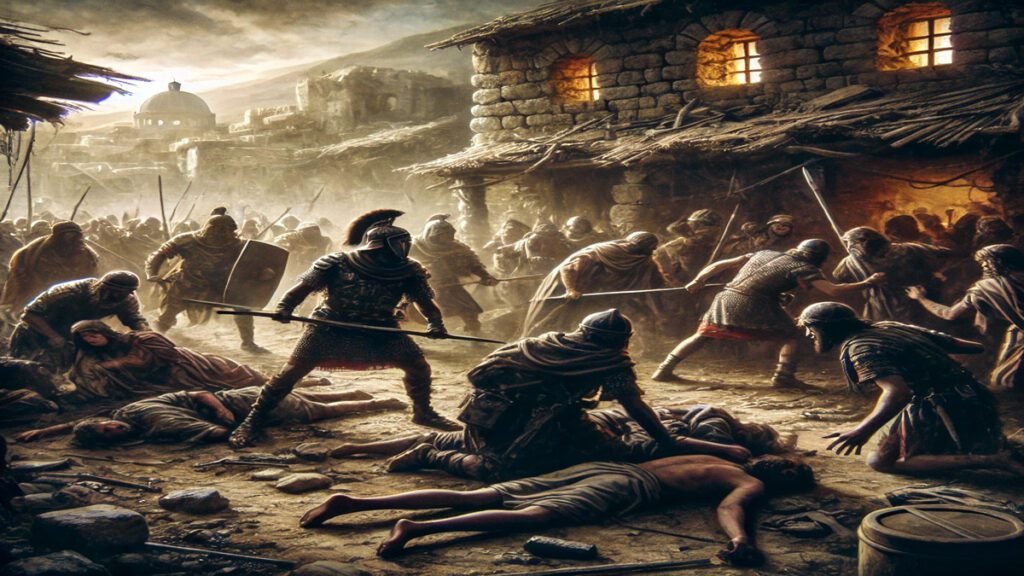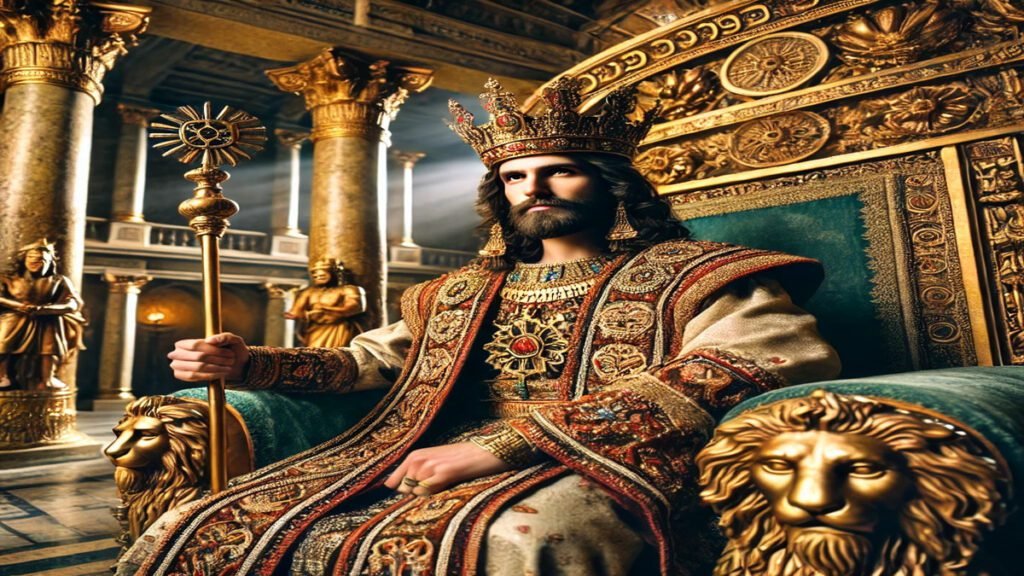King Herod, often called Herod the Great, was a towering yet deeply polarizing figure in ancient Judea. His story is one of ambition, political cunning, family drama, and ultimately, a tragic downfall.
Herod’s Rise to Power
Born around 73 BC to Antipater, an Idumean, and Cyprus, a Nabatean Arab, Herod’s background was marked by political turbulence. His father, a close ally of Julius Caesar, secured Herod a role as governor of Galilee at just 25 years old. Even at this young age, Herod demonstrated his ruthlessness by swiftly dealing with bandits in Galilee, earning Roman favor.
The Romans, then the dominant power in the region, viewed Herod as a useful ally in their control of Judea. In 40 BC, the Roman Senate declared him “King of the Jews,” but his throne wasn’t secure. He fought a grueling three-year campaign to reclaim Jerusalem from Antigonus II, the last Hasmonean king, solidifying his rule in 37 BC.
The Builder King
Herod earned his title “the Great” for his architectural feats. He was a visionary builder who transformed Judea, leaving a legacy still visible today. Among his most famous projects were:
- The Temple in Jerusalem: Herod expanded the Second Temple, making it one of the most magnificent structures of its time (John 2:20). The expansion symbolized both Herod’s ambition and his attempt to curry favor with Jewish society, though it was viewed with suspicion by many.
- Masada and Herodium: Fortresses that symbolized his power and paranoia. Herodium also served as his eventual burial place, a testament to his obsession with legacy.
- Caesarea Maritima: A grand port city showcasing Roman influence, complete with a massive harbor, aqueducts, and a theater, blending Hellenistic and Roman styles.
- The Antonia Fortress: A military stronghold near the Temple in Jerusalem, emphasizing Herod’s constant vigilance against rebellion.
However, Herod’s grandeur came at a price. Heavy taxation and forced labor caused resentment among his subjects, particularly among devout Jews, who viewed him as a puppet of Rome and a betrayer of Jewish traditions.
Family Struggles and Paranoia
Herod’s personal life was as tumultuous as his political career. He married at least ten wives and fathered numerous children. His most famous wife was Mariamne I, a Hasmonean princess. Though their union was meant to solidify his claim to the throne, it ended in tragedy.
Wives and Children
- Doris: Herod’s first wife, whom he divorced to marry Mariamne I. Their son, Antipater, was executed by Herod for treason.
- Mariamne I: A Hasmonean princess deeply loved by Herod. However, consumed by jealousy and paranoia, he had her executed in 29 BC. Her death devastated Herod and intensified his mental instability.
- Mariamne II: Daughter of the high priest Simon, married for political reasons. Herod later executed her father, further alienating the priestly class.
- Malthace: A Samaritan woman and mother of Herod Antipas, who later ruled Galilee and Perea, and Archelaus, who ruled Judea briefly.
- Cleopatra of Jerusalem: Little is known about her, but she bore Herod a son, Philip the Tetrarch, who became known for his relatively fair and peaceful rule.
Herod’s paranoia led him to execute not only his beloved Mariamne but also three of his sons—Alexander, Aristobulus, and Antipater. His family dysfunction prompted Caesar Augustus to famously quip, “It is better to be Herod’s pig than his son.”
The rivalries among his children continued after Herod’s death, fracturing his dynasty and weakening its grip on power.
Herod and the Birth of Jesus
Herod’s most infamous act, according to the New Testament, was the Massacre of the Innocents (Matthew 2:16-18). Upon learning of Jesus’ birth from the Magi, Herod, terrified of losing his throne to the “King of the Jews,” ordered the killing of all male children under two in Bethlehem. Though some historians debate this event’s historicity, it aligns with Herod’s known cruelty and paranoia. This act also fulfilled the prophecy in Jeremiah 31:15, adding a layer of spiritual significance.

The End of Herod the Great
Herod’s final years were marked by excruciating physical and mental suffering. He was afflicted with a painful, mysterious illness, described by the Jewish historian Josephus as including gangrene, convulsions, and an unbearable stench. Modern scholars suggest conditions like chronic kidney disease or Fournier’s gangrene.
Despite his suffering, Herod’s paranoia didn’t wane. Shortly before his death in 4 BC, he ordered the arrest of numerous prominent Judean citizens, commanding that they be executed upon his death to ensure mourning throughout the land. Fortunately, this order was never carried out.
Herod died in his palace in Jericho, a broken man, despised by many. He was buried in Herodium, one of the fortresses he built.
Legacy
King Herod left behind a complex legacy:
- Politically, he was a shrewd leader who maintained Judea’s precarious balance as a Roman client state.
- Architecturally, his achievements were unparalleled in the ancient Near East.
- Personally, his life was a cautionary tale of ambition overshadowed by paranoia and cruelty.
Herod’s dynasty lived on through his surviving children, such as Herod Archelaus, Herod Antipas, and Philip the Tetrarch, who ruled parts of his divided kingdom after his death. Notably:
- Herod Antipas: Ruler of Galilee and Perea, responsible for the execution of John the Baptist (Matthew 14:1-12). He also played a role in Jesus’ trial (Luke 23:7-12).
- Philip the Tetrarch: Governed Iturea and Trachonitis, known for his fair and effective rule compared to his siblings.
- Archelaus: Briefly ruled Judea but was so brutal that the Romans replaced him with direct governance.
Spiritual Lessons from Herod’s Story

Herod’s life is a sobering reminder of the dangers of unchecked ambition, fear, and the inability to trust in God. Despite his worldly power and achievements, he lacked peace and joy. In contrast, the infant Jesus, whom Herod sought to destroy, brought hope, humility, and salvation to the world.
Contrast with Jesus’ Kingship
Herod’s relentless pursuit of power and control contrasts sharply with Jesus’ humble leadership and message of servanthood. While Herod sought to dominate, Jesus sought to serve (Matthew 20:26-28).
Lessons on Fear and Control
Herod’s story challenges us to examine how fear and insecurity can lead to destructive actions. True peace comes not from earthly power but from trusting in God’s eternal plan.
References
- Matthew 2:1-18 (The Birth of Jesus and the Massacre of the Innocents)
- Josephus, Antiquities of the Jews (Books 14-17)
- Luke 23:7-12 (Herod Antipas and Jesus’ Trial)
- Matthew 14:1-12 (Execution of John the Baptist)
Herod the Great stands as a figure both fascinating and tragic, his story woven into the fabric of biblical history. His life challenges us to examine our own ambitions and fears in the light of God’s eternal plan.



